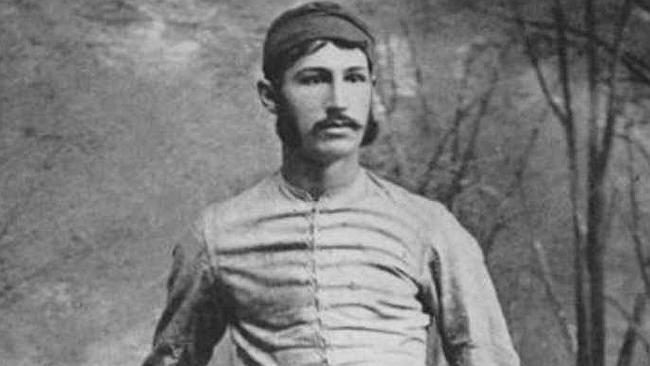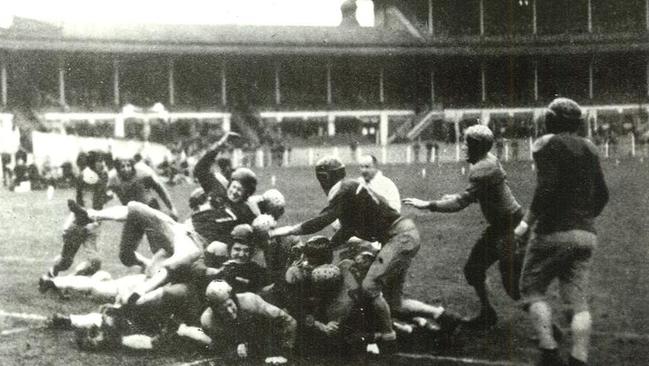Gridiron born of need for level playing field
Perhaps we shouldn’t be surprised if Jarryd Haynes’ NFL dream comes true. Despite their obvious differences, rugby league and gridiron have some things in common, particularly their origins in rugby union.

Today in History
Don't miss out on the headlines from Today in History. Followed categories will be added to My News.
W hen Jarryd Hayne made a 33-yard run against the Houston Texans during a pre-season game on the weekend, the former Parramatta Eel went a long way to silencing critics who thought he would never make the transition to the NFL.
But perhaps we shouldn’t be surprised if Haynes’ dream comes true. Despite their obvious differences, rugby league and gridiron have some things in common, particularly their origins in rugby union.
When the British first colonised parts of North America in the 17th century they brought with them all kinds of ball games. In the days before rules were routinely recorded, there were many different kinds of games played in colleges, schools and parks.
COMMON GROUND
The catalyst for the development of the American code was the need for common rules so college teams could play each other. Although America had broken away from the British during the War of Independence in the 18th century, there was still a lot of cultural exchange between the countries in the 19th century. American educational institutions often adopted British traditions, particularly the practice of students playing competitive amateur sports to keep fit.
Some colleges adopted the hands-free football that came to be known as Association Football or soccer. Others adopted the game developed at the Rugby School in Warwickshire which involved picking up the ball and running with it.
According to legend, Rugby pupil William Webb Ellis started that trend in 1823 when he picked up the ball during a football match, although there is no direct evidence of this incident having actually occurred. By 1845 handling the ball had become part of the written rules of rugby. As early as 1843 there had been attempts to codify soccer but it was only in 1863 that there was wide agreement on, and publication of, the rules.

‘THE BOSTON GAME’
Other American colleges persisted with their own rules or in cases such as Harvard combined what they liked about soccer and rugby in a game dubbed “The Boston Game”.
Soccer was the dominant code for a while but in 1873 the colleges combined to found the Intercollegiate Football Association (IFA) and rugby started to have a bigger impact, although Harvard continued playing its own code.
That ended in 1874 when Harvard agreed to a series of games with the University of Montreal and played one matche according to rugby rules. Deciding they preferred rugby, the Harvard team abandoned The Boston Game, opening the way for competition against IFA teams. In 1875 it played Yale in a rugby match, winning 4-0 and instituting one of the great sporting rivalries. In 1876 a new IFA was formed with rugby as the primary code.
CHANGING THE RULES
But Americans didn’t like all aspects of rugby and there was more tinkering with the rules. Much of the tinkering was under the impetus of medical student, footballer and member of the IFA rules committee, Walter Camp.
One of the first changes was the reduction of players on the field from 15 to 11. In 1880 Camp also did away with scrums and implementing the line of scrimmage.
To prevent one team dominating possession of the ball he also introduced the rule of having to make 10 yards within three plays or downs. He also changed the scoring system so touchdowns, previously worth no points but allowing a kick for goal, were now awarded two points (in 1912 this was changed to six).
The game’s popularity grew and it departed further from rugby by going professional in the 1890s, with William Heffelfinger the first player paid to play.
DEADLY COST
Initially the sport was so violent that rules had to be inscribed banning players wearing metal plates and studs. Protective padding was introduced in the 1890s but severe injuries and even deaths continued to mount until, in 1905, with 19 reported deaths President Theodore Roosevelt threatened to abolish the game if steps were not taken to curb the violence.
In 1906 reforms were passed and more would follow in 1909, further modifying what was once a form of rugby and creating the modern game, one of America’s favourite obsessions.
Originally published as Gridiron born of need for level playing field



